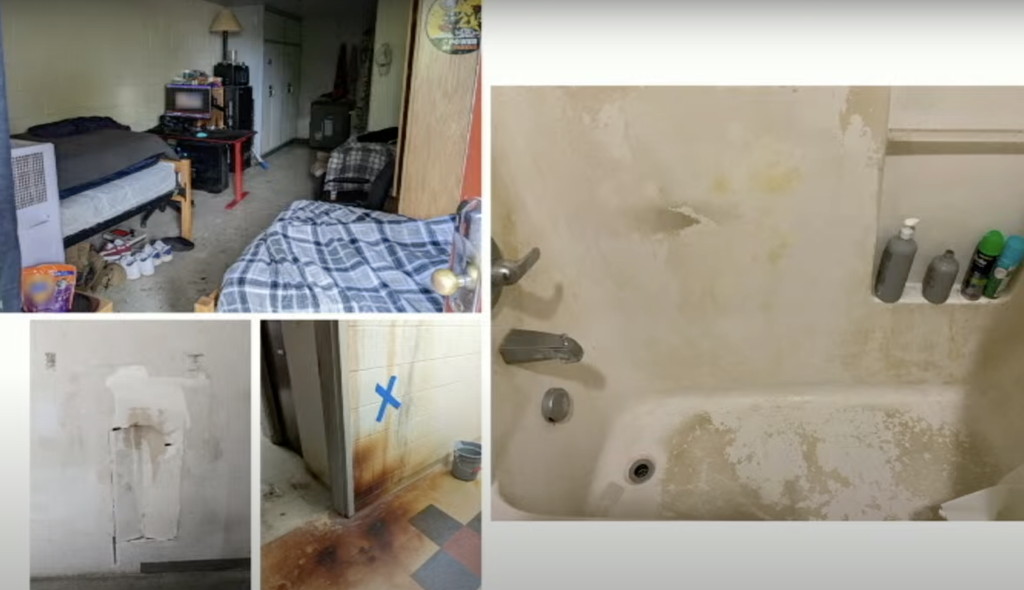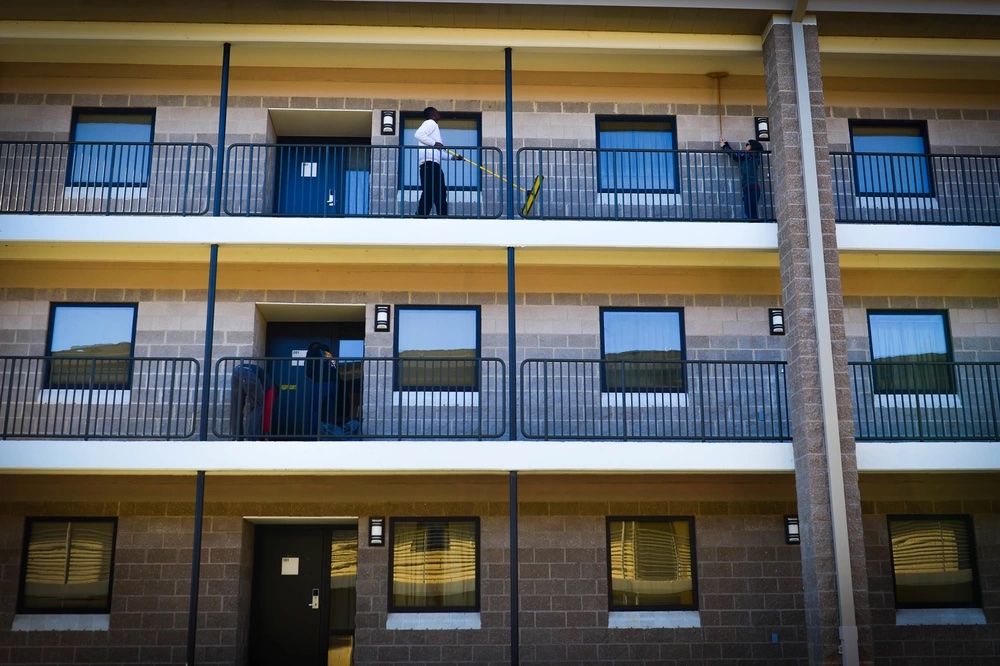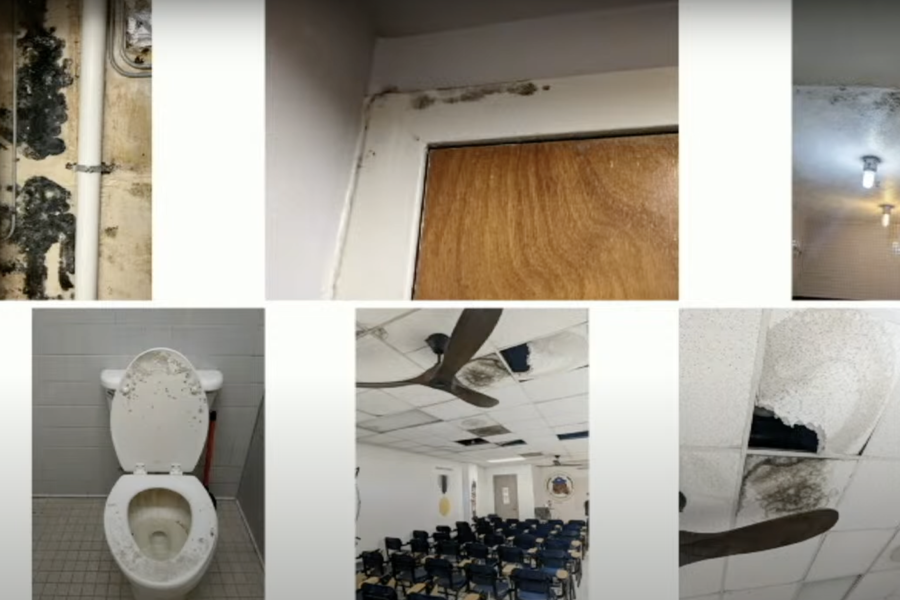A week after publishing a report on unhealthy and unsafe living conditions found in military barracks across the services, the Government Accountability Office released a follow-up study on improving oversight of conditions for both government-owned barracks and privatized housing.
“We believe that the recommendations in our report, if fully implemented, will put the department on a better footing to address this substantial challenge,” Elizabeth Field, GAO’s director for defense capabilities and management, told members of the House Armed Services Committee in a Sept. 27 hearing. “But it will take years to reverse the chronic neglect and underfunding we uncovered.”
For its initial report, GAO visited 10 installations and found a range of substandard conditions that affected service members’ mental and physical health, such as broken air conditioning, malfunctioning fire safety systems, vacant units occupied by unauthorized personnel, and broken first-floor windows, as well as mold growth, water quality problems, bedbugs, cockroaches, and overcrowded dorm rooms.
The GAO did not specify which services the affected installations belonged to, but it identified shortcomings in how each service oversees barracks, where junior enlisted unmarried service members are often required to live. The Air Force calls such facilities dormitories, but the GAO used ‘barracks’ as a catch-all term to include dormitories. Lawmakers were incensed by the report.
“I was a base commander at Ramstein and at Offutt Air Force Base,” Rep. Don Bacon (R-Neb.), a retired Air Force brigadier general, said during the hearing. “If I would have had these conditions in any of our barracks, I would have got fired.”
For their part, installation commanders “felt sick” about barracks conditions and faced “impossible choices” in terms of funding, Field said, but the Office of the Secretary of the Defense had a “hands-off” approach despite its obligation to oversee barracks programs.
Considering the fierce competition for limited funding, she said the way to resolve the issue is for the department to have better awareness of barracks conditions and better tracking of barracks funding so it can more finely reevaluate and enforce its housing policies.
“Our hope is … that the department develop a joint strategy so the services can learn from one another, so that standards can be put in place that are consistent, to try to get behind this problem,” she said.

Better assessments
Many of the recommendations for the services and the Defense Department involved revamping how the they conduct condition assessments—as an example, GAO analysis showed that nearly 50 percent of Air Force dormitories considered ‘at risk of significant degradation’ had a condition score of 80 or above. The Defense Department needs to reevaluate those assessments and offer guidance based on its findings, authors wrote.
The GAO also recommended the services and the Office of the Secretary of Defense ask service members how housing conditions affect their quality of life. While the Navy and Marine Corps conduct annual tenant satisfaction surveys for government-owned barracks, the Army and the Air Force do not. Air Force officials sometimes administer surveys at the installation level, but there is no department-wide system, which leaves a major blindspot for service leaders, GAO noted.
“We recommended that DOD update guidance to require surveys of barracks residents—thousands of whom live in barracks because they are required to do so,” the authors said. “Implementing our recommendation will ensure DOD is positioned to assess the effects of barracks conditions and identify potential improvements.”
Better oversight
Another flaw GAO identified in military barracks programs was an inadequate system for monitoring substandard barracks, tracking budget information, and coordinating inter-service collaboration. The Office of the Secretary of the Defense was unaware that the services generally did not meet its standards for privacy and barracks amenities, nor were they monitoring the number of substandard barracks.
The GAO also found that the Pentagon does not comprehensively track how much money the services spend on barracks. The three funding accounts are Operation and Maintenance, Military Construction, and Military Personnel, but it is difficult to know how much of these are spent on barracks improvements and if it is enough. Field indicated it is not.
“The facilities that most often lose out are things like barracks,” she said at the Congressional hearing. “Eventually if you don’t fund sustainment enough, you’re going to need to build an entirely new barracks, which means you need new MILCON—military construction funding.”
Field said part of the problem is a ‘tough it out’ mindset that minimizes poor housing conditions.
“I think there has been a cultural perspective within the department that ‘part of being in the military is toughing it out,’ and ‘this is just going to get them ready for the military,’” she said. “Unfortunately I think that has gotten us in part to where we are today.”

GAO recommended the Defense Department develop better methods for tracking and reporting complete and accurate funding information and for increasing department-wide collaboration on housing programs. Study authors made a similar recommendation for privatized family housing, which has also suffered from inconsistent oversight and inspection standards.
“These problems are, unfortunately, not dissimilar from the ones we have observed and documented in privatized family housing,” Field said. “The only real difference is that the Defense Department has felt more pressure in recent years to fix the problems in family housing than it has to fix the problems with barracks.”
For their part, service officials were dismayed by the GAO’s report. Robert Moriarty, deputy assistant secretary of the Air Force for installations, said the service needs to regain its focus on facility maintenance. He said the service now has “a focused fund” dedicated to dormitories.
Meanwhile, Brendan Owens, the Defense Department’s chief housing officer, said in a press release that the department has “in too many instances, failed to live up to our role” of maintaining adequate housing.
“I will move out aggressively to increase oversight and accountability in government-owned unaccompanied housing and to address unacceptable living conditions impacting our service members,” he said. “My office will work with the military departments to ensure that you have a safe and secure place to live. Collectively, we will improve our responsiveness to your concerns.”
